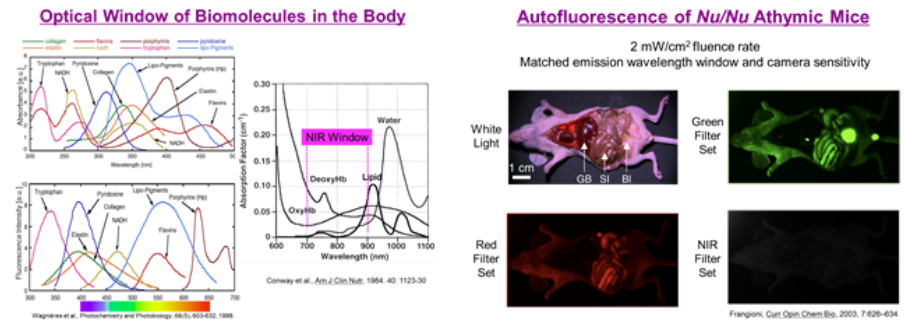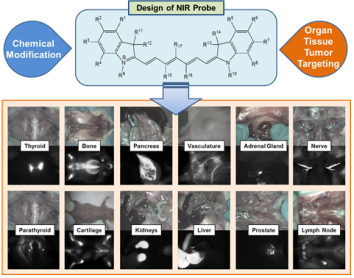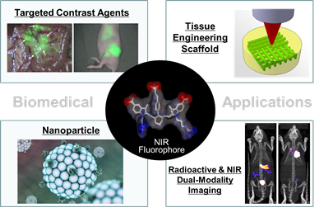본문
| Department | Biomedical Sciences |
|---|---|
| Major Field of Research | Molecular imaging, Drug delivery system, Biomaterials and Cancer therapy |
| hhyun@jnu.ac.kr | |
| Homepage |
Research interests
Hoon Hyun’s laboratory has focused on the development of novel fluorescent imaging agents for target-specific imaging and therapy. A single fluorophore could be designed to control the pharmacophore to binding sites of the target tissues directed by structure-inherent chemical recognition. Thus, the single compact fluorophore performs both targeting and imaging, simultaneously. This strategy is the paradigm shift in a role of fluorophores from traditional method used for covalent conjugation of targeting ligands and fluorescence imaging agents.
1. Development of near-infrared fluorophores for organ- and tissue-specific imaging
- The development of real-time image guidance, where it provides a surgeon direct image guidance to the target of the interest, is needed to avoid many surgical problems such as incomplete resection of cancerous tissues or damage to nerves or blood vessels. Optical imaging provides real-time visualization of the surgical field, allowing intraoperative image-guided surgery.
- We focus on the molecular design required for developing tissue-specific probes and the biological infrastructure to be overcome or harnessed to achieve selective tissue imaging.
2. Development of disease-specific near-infrared fluorophores
- Long-term survival of cancer patients depends on the ability to fully resect tumorous tissue while avoiding vital tissue present on the surgical field.
- A structure-inherent targeting strategy would help overcome the obstacles of targeting ligand-based contrast agent to native tissues and sensitive glands, which remains a longstanding clinical problem in contrast agent development. We suggest that the molecular character may be modified and finely tuned to achieve selective uptake with high signal-to-background ratio in particular tissues using a structure-inherent approach that exploits chemical recognition to biological tissue for targeting and biodistribution.
3. Cancer-targeted near-infrared fluorophores for efficient phototherapy
- Near-infrared light-induced phototherapy has been approved as a highly accurate therapeutic strategy with high selectivity and minimal side effects. Phototherapeutic agents can absorb light energy and cause local hyperthermia and/or reactive oxygen species generation, resulting in cancer cell death.
- The key to successful phototherapy is cancer-targeted fluorescence imaging using functional near-infrared fluorophores for precise light treatment and efficient photosensitization in the tumors.
4. Drug-mimicking near-infrared fluorophores for targeted cancer chemotherapy
- Using the known affinities of bisphosphonates for bone minerals, we suggest a new strategy based on incorporation of phosphonate moieties into the chemical structure of polymethine indocyanines. As the results of this concept, the phosphonated near-infrared fluorophores could increase bone strength, acting like bisphosphonate drugs, and improve bone density by preventing the loss of minerals.
- We recently found that one of targeted near-infrared fluorophores showed significant tumor accumulation and effective tumor suppression in breast cancer xenograft models after systemic intravenous administration.



근적외선 형광물질의 개발을 통한 다양한 바이오 의료 분야에의 적용 가능성
Publication
- Jo G, Lee BY, Kim EJ, Park MH, Hyun H.* Indocyanine green and methyl-β-cyclodextrin complex for enhanced photothermal cancer therapy. Biomedicines. 2020; 8(11):476.
- Park MH, Jo G, Kim EJ, Jung JS, Hyun H.* Tumor-targeted near-infrared fluorophore for fluorescence-guided phototherapy. Chem Commun. 2020; 56(30):4180-4183.
- Lim W, Jo G, Kim EJ, Cho H, Park MH, Hyun H.* Zwitterionic near-infrared fluorophore for targeted photothermal cancer therapy. J Mater Chem B. 2020; 8(13):2589-2597.
- Lee S, Jo G, Jung JS, Yang DH, Hyun H.* Near-infra-red fluorescent chitosan oligosaccharide lactate for targeted cancer imaging and photothermal therapy. Artif Cells Nanomed Biotechnol. 2020; 48(1):1144-1152.
- Yoo Y, Jo G, Jung JS, Yang DH, Hyun H.* Multivalent sorbitol probes for near-infrared photothermal cancer therapy. Part Part Syst Charact. 2020; 37(2):1900490.
- Lee S, Jung JS, Jo G, Yang DH, Koh YS, Hyun H.* Near-infrared fluorescent sorbitol probe for targeted photothermal cancer therapy. Cancers. 2019; 11(9):1286.
- Lee S, Lim W, Jo D, Jung JS, Kim S, Jo G, Min JJ, Choi EY, Hyun H.* Near-infrared fluorescent sorbitol probe for tumor diagnosis in vivo. J Ind Eng Chem. 2018; 64:80-84.
- Park MH, Lim W, Jo D, Jung JS, Kim S, Kim J, Lim HS, Lee JS, Min JJ, Hyun H.* Rapid differential diagnosis of breast microcalcification using targeted near-infrared fluorophores. Adv Healthc Mater. 2018; 7(7):1701062.
- Lee S, Lim W, Ryu HW, Jo D, Min JJ, Kim HS, Hyun H.* ZW800-1 for assessment of blood-brain barrier disruption in a photothrombotic stoke model. Int J Med Sci. 2017; 14(13):1430-1435.
- Lim W, Sohn H, Ko Y, Park M, Kim B, Jo D, Jung JS, Yang DH, Kim J, Kim OJ, Kim D, Moon YL, Min JJ, Hyun H.* Real-time in vivo imaging of metastatic bone tumors with a targeted near-infrared fluorophore. Oncotarget. 2017; 8(39):65770-65777.
etc
- Member of The Korean Society for Biomaterials, The Korean Society of Industrial and Engineering Chemistry, Korean Tissue Engineering and Regenerative Medicine Society, The Polymer Society of Korea, The Pharmaceutical Society of Korea, Optical Society of Korea

